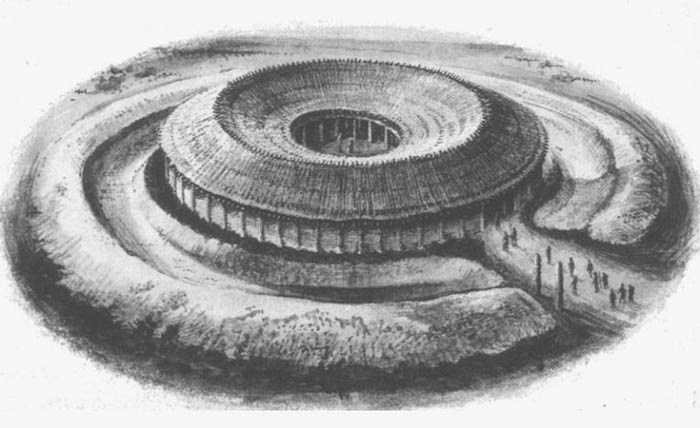

A sketch
of Durrington Walls. Durrington Walls was 2 miles away from
Stonehenge.
Durrington Walls seems to be where Stonehenge's
builders resided. This place was also where the visitors of
Stonehenge stayed during their visit. Durrington Walls was a
'henge' as well, meaning it was a monument consisting of
wooden uprights in an elliptical shape, and is 480 yards in
diameter. Many lived there; the houses within the enclosure
were small, but cozy. There were clay floors, hearths,
chimneys, and wooden box beds.Thousands of animals were
butchered and eaten there, primarily pigs, due to the high
number of pig bones found. Durrington Walls also had a social
structure; those of high social classes lived near the center.
That is proven by how more furniture and items have been
excavated from those homes. Additionally, it is said that the
settlement was not preoccupied all through out the year, that
inhabitants came there during very specific times such as the
winter solstice, or during funerary rites. There were also
numerous ceremonies called pantagruelic banquets, where feasts
took place, explaining the many animal bones found.
Durrington Walls "is either the richest site or the
filthiest that we have ever found for this period," Pearson
said. "It's absolutely stuffed full of trash or rubbish:
broken pots, chips, flints, burned stones used for cooking and
animal bones. Many were thrown away half eaten, a sign of
conspicuous consumption. This is an enormous feasting
assemblage. People were here to have a really good time."
-Mark Pearson of Sheffield University
Building Durrington Walls of course took as much
dedication and effort as Stonehenge. Ancient diggers did not
have metal tools, so all that digging was done by picks made
by deer antlers. Another thing to consider, is that there were
no trees nearby in the area, so the wooden posts were brought
from a considerable distance.
LINKS
Ctrl+Mouse Click to open in new tab or right click open tab





